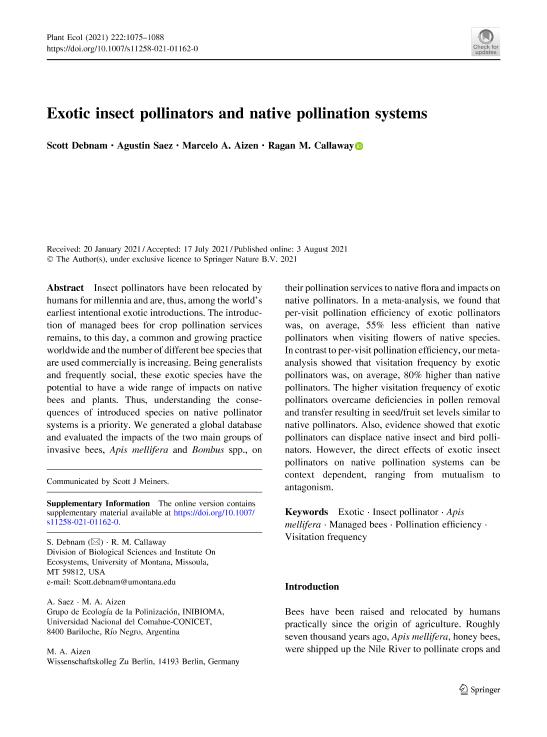Mostrar el registro sencillo del ítem
dc.contributor.author
Debnam, Scott
dc.contributor.author
Sáez, Agustín

dc.contributor.author
Aizen, Marcelo Adrian

dc.contributor.author
Callaway, Ragan M.
dc.date.available
2023-01-06T09:56:45Z
dc.date.issued
2021-09
dc.identifier.citation
Debnam, Scott; Sáez, Agustín; Aizen, Marcelo Adrian; Callaway, Ragan M.; Exotic insect pollinators and native pollination systems; Springer; Plant Ecology; 222; 9; 9-2021; 1075-1088
dc.identifier.issn
1385-0237
dc.identifier.uri
http://hdl.handle.net/11336/183673
dc.description.abstract
Insect pollinators have been relocated by humans for millennia and are, thus, among the world’s earliest intentional exotic introductions. The introduction of managed bees for crop pollination services remains, to this day, a common and growing practice worldwide and the number of different bee species that are used commercially is increasing. Being generalists and frequently social, these exotic species have the potential to have a wide range of impacts on native bees and plants. Thus, understanding the consequences of introduced species on native pollinator systems is a priority. We generated a global database and evaluated the impacts of the two main groups of invasive bees, Apis mellifera and Bombus spp., on their pollination services to native flora and impacts on native pollinators. In a meta-analysis, we found that per-visit pollination efficiency of exotic pollinators was, on average, 55% less efficient than native pollinators when visiting flowers of native species. In contrast to per-visit pollination efficiency, our meta-analysis showed that visitation frequency by exotic pollinators was, on average, 80% higher than native pollinators. The higher visitation frequency of exotic pollinators overcame deficiencies in pollen removal and transfer resulting in seed/fruit set levels similar to native pollinators. Also, evidence showed that exotic pollinators can displace native insect and bird pollinators. However, the direct effects of exotic insect pollinators on native pollination systems can be context dependent, ranging from mutualism to antagonism.
dc.format
application/pdf
dc.language.iso
eng
dc.publisher
Springer

dc.rights
info:eu-repo/semantics/openAccess
dc.rights.uri
https://creativecommons.org/licenses/by-nc-sa/2.5/ar/
dc.subject
APIS MELLIFERA
dc.subject
EXOTIC
dc.subject
INSECT POLLINATOR
dc.subject
MANAGED BEES
dc.subject
POLLINATION EFFICIENCY
dc.subject
VISITATION FREQUENCY
dc.subject.classification
Ecología

dc.subject.classification
Ciencias Biológicas

dc.subject.classification
CIENCIAS NATURALES Y EXACTAS

dc.title
Exotic insect pollinators and native pollination systems
dc.type
info:eu-repo/semantics/article
dc.type
info:ar-repo/semantics/artículo
dc.type
info:eu-repo/semantics/publishedVersion
dc.date.updated
2022-10-06T13:12:22Z
dc.journal.volume
222
dc.journal.number
9
dc.journal.pagination
1075-1088
dc.journal.pais
Alemania

dc.journal.ciudad
Berlin
dc.description.fil
Fil: Debnam, Scott. University of Montana; Estados Unidos
dc.description.fil
Fil: Sáez, Agustín. Consejo Nacional de Investigaciones Científicas y Técnicas. Centro Científico Tecnológico Conicet - Patagonia Norte. Instituto de Investigaciones en Biodiversidad y Medioambiente. Universidad Nacional del Comahue. Centro Regional Universidad Bariloche. Instituto de Investigaciones en Biodiversidad y Medioambiente; Argentina
dc.description.fil
Fil: Aizen, Marcelo Adrian. Consejo Nacional de Investigaciones Científicas y Técnicas. Centro Científico Tecnológico Conicet - Patagonia Norte. Instituto de Investigaciones en Biodiversidad y Medioambiente. Universidad Nacional del Comahue. Centro Regional Universidad Bariloche. Instituto de Investigaciones en Biodiversidad y Medioambiente; Argentina
dc.description.fil
Fil: Callaway, Ragan M.. University of Montana; Estados Unidos
dc.journal.title
Plant Ecology

dc.relation.alternativeid
info:eu-repo/semantics/altIdentifier/url/https://doi.org/10.1007/s11258-021-01162-0
dc.relation.alternativeid
info:eu-repo/semantics/altIdentifier/doi/http://dx.doi.org/10.1007/s11258-021-01162-0
Archivos asociados
